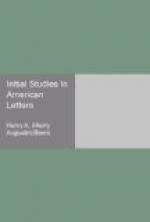Humphreys became afterward distinguished in the diplomatic service, and was, successively, embassador to Portugal and to Spain, whence he introduced into America the breed of merino sheep. He had been on Washington’s staff during the war, and was several times an inmate of his house at Mount Vernon, where he produced, in 1785, the best-known of his writings, Mount Vernon, an ode of a rather mild description, which once had admirers. Joel Barlow cuts a larger figure in contemporary letters. After leaving Hartford, in 1788, he went to France, where he resided for seventeen years, made a fortune in speculations, and became imbued with French principles, writing a song in praise of the guillotine, which gave great scandal to his old friends at home. In 1805 he returned to America and built a fine residence near Washington, which he called Kalorama. Barlow’s literary fame, in his own generation, rested upon his prodigious epic, the Columbiad. The first form of this was the Vision of Columbus, published at Hartford in 1787. This he afterward recast and enlarged into the Columbiad, issued in Philadelphia in 1807, and dedicated to Robert Fulton, the inventor of the steam-boat. This was by far the most sumptuous piece of book-making that had then been published in America, and was embellished with plates executed by the best London engravers.
The Columbiad was a grandiose performance, and has been the theme of much ridicule by later writers. Hawthorne suggested its being dramatized, and put on to the accompaniment of artillery and thunder and lightning; and E. P. Whipple declared that “no critic in the last fifty years had read more than a hundred lines of it.” In its ambitiousness and its length it was symptomatic of the spirit of the age which was patriotically determined to create, by tour de force, a national literature of a size commensurate with the scale of American nature and the destinies of the republic. As America was bigger than Argos and Troy we ought to have a bigger epic than the Iliad. Accordingly, Barlow makes Hesper fetch Columbus from his prison to a “hill of vision,” where he unrolls before his eye a panorama of the history of America, or, as our bards then preferred to call it, Columbia.




